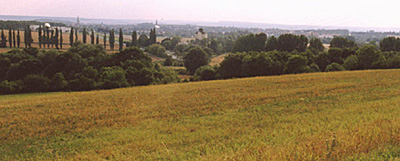 The Austro-Prussian War (Seven Weeks War) of June-July 1866 must rank as the least celebrated conflict with the greatest impact on European affairs of the modern era.
The Austro-Prussian War (Seven Weeks War) of June-July 1866 must rank as the least celebrated conflict with the greatest impact on European affairs of the modern era.
View from the Kirchberg, looking southwest over the Unstrut valley and Bad Langensalza. Tower of Kallenbergsmuhle visible at center.
The Franco-Prussian War of 1870-71 is seen as the catalyst of German unification under Prussian hegemony, but that issue was effectively decided in 1866.
The scant attention devoted to the 1866 war may be explained by considering the propaganda interests of the major powers over the ensuing 79 years: Germany's foes in 1870-1945 emphasized the monolithic menace of the Boches/Huns/Jerries, and German leaders had even less to gain by reminding their citizens that blood was shed in internecine warfare between German armies fighting for their respective kings and countries in 1866.
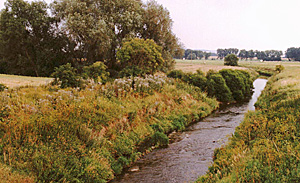 River Unstrut, looking southeast from Merxleben bridge.
River Unstrut, looking southeast from Merxleben bridge.
Living in Germany for ten of the past thirteen years has heightened my awareness of German regional differences, tensions, and antipathies. The Fall of the Wall in 1989, ardently desired as it was, led to much uncomfortable confrontation between Ossis and Wessis that was not entirely due to economic and political differences: I believe that Bavarians, Wurttembergers, Hessians, Hanoverians, et al had been glad to be rid of the Prussians for a generation. Some of their resentment can be traced back to the military and political humiliation of the western German states in 1866.
Bloodiest Clash
Langensalza, now known as Bad Langensalza, was the site of the largest and bloodiest clash of the 1866 Campaign in Western Germany. It was also the only significant tactical defeat suffered by Prussian forces in the war.
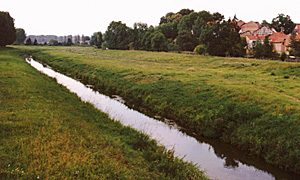 River Unstrut, looking northwest from the Merxleben bridge. Edge of Merxleben village visible at right.
River Unstrut, looking northwest from the Merxleben bridge. Edge of Merxleben village visible at right.
Upon the outbreak of hostilities and the invasion of Hanover on 15 June 1866 by the Prussian Army of the Main, the Hanoverian command made the difficult but strategically necessary decision to abandon their country and save their army by marching south to link up with the allied forces of Bavaria, Wurttemberg, Baden, Hesse, and Nassau. Had this maneuver succeeded, the 48,000 Prussians of the Army of the Main might have been faced with a combined opposition of 119,000 Federal troops. It was in the context of strenuous Prussian maneuvering to prevent this link-up that General von Flies, aggressively interpreting his orders to remain close upon the enemy, threw his ill-prepared detachment of 8500 Prussians northward from Gotha against 20,000 Hanoverians strongly positioned along the Unstrut River immediately to the northeast of Langensalza.
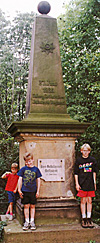
The principal action of the Battle of Langensalza took place along the River Unstrut within a few hundred meters upstream and downstream of the Merxleben bridge. General von Flies could only have been acting under the influence of breathtaking arrogance and an assumption of the crushing moral ascendancy of Prussia's manifest destiny, to believe that a frontal attack into the center of the Hanoverian position could result in anything but a bloody repulse.
The Prussian Advance Guard, built around the two-battalion Saxe-Coburg-Gotha Regiment (probably including friends and relations of Britain's Prince Albert) cleared the Hanoverian outposts from Langensalza and occupied the Judenhugel rise by 1130.
Prussian Saxe-Coburg-Gotha Regiment memorial on the Judenhugel.
Most of the Prussian artillery, which totalled 22 guns of which six only were rifled (PGS p. 48) including a number of puny 4-pounders, deployed on the Judenhugel and dueled with the Hanoverian batteries across the river. These included twelve rifled 6-pounders and three 12-pounders on the Kirchberg, six rifled 6-pounders west of Merxleben, and a further four rifled 6-pounders and four horse-guns firing from a flanking position east of Merxleben.
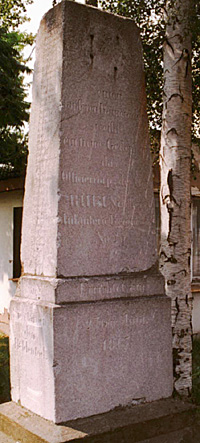
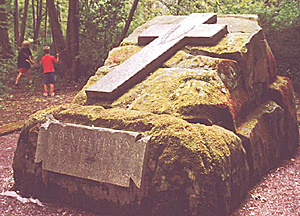 The Prussian 25th (Rhineland) Infantry (Regimental memorial, on the grounds of the
Kallenbergsmuhle, at right) and 11th Grenadier Regiment (Regimental memorial, in the Badewaldchen, at left) were committed by companies into the firing-line from the north of the Kallenbergsmuhle to the Badewaldchen (the small wood by the baths, awkwardly translated in PGS as Bad Plantation), with much mixing of units.
The Prussian 25th (Rhineland) Infantry (Regimental memorial, on the grounds of the
Kallenbergsmuhle, at right) and 11th Grenadier Regiment (Regimental memorial, in the Badewaldchen, at left) were committed by companies into the firing-line from the north of the Kallenbergsmuhle to the Badewaldchen (the small wood by the baths, awkwardly translated in PGS as Bad Plantation), with much mixing of units.
An attempt by the 7th Company of the 25th Infantry starting from the Kallenbergsmuhle to storm the Merxleben bridge between 1200 and 1230 was beaten back, but some skirmishers succeeded in crossing the river and harassing the Hanoverian gunners on the Kirchberg.
At about 1330, with Prussian artillery fire slackening as munitions ran low and most of the Prussian reserves long since committed and fatigued, Hanoverian General von Arentschildt brought up two fresh brigades (Knesebeck's Hanoverian Guards and Bulows 3rd) and launched a general assault across the Unstrut. The Prussian left collapsed, many men taking shelter among the buildings of the Kallenbergsmuhle where they surrendered about 1400.
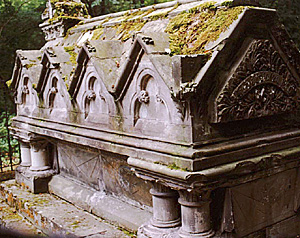 Battlefield grave of Second Lieutenant Bernhard Deit, 1 Rheinisches Infanterie-Regiment No. 25 in Badewaldchen.
Battlefield grave of Second Lieutenant Bernhard Deit, 1 Rheinisches Infanterie-Regiment No. 25 in Badewaldchen.
Hanoverian infantry spread through the town and were soon firing into the flank and rear of the Prussians on the Judenhugel, forcing a rapid retreat to the south.
The Prussian General Staff history takes some pains to describe small-scale heroics during the withdrawal. The following excerpt gives some flavor of the encounters.
- The Prussian right wing was withdrawing in fairly good order, pursued by the Hanoverian Duke of Cambridge Dragoon Regiment (another reminder of Hanover's close ties with the British Royal Family).
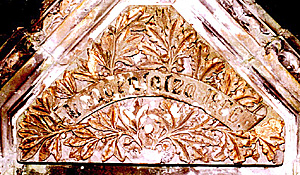 Detail of Deit's grave.
Detail of Deit's grave.
One of these squadrons attacked the two guns of the Sally Battery, which were marching with the 3rd Company of the Depot Battalion (71st Regiment), now numbering only 30 men, in the middle Illeben Road. Notwithstanding canister fire and two salvos from the Infantry, several Dragoons, with the squadron leader Captain Einem at their head, burst into the artillery division, but were for the most part either killed or taken. The remainder fled, pursued by the garrison squadron of the 12th (Merseburg Landwehr) Hussars. The draught horses were however frightened, bolted, and fell in a hollow road immediately in rear, out of which it was impossible to get them.
In vain several detachments of infantry manned the guns. As no means of dragging them out could be sent, they were obliged to be left lying, and were so found by the Hanoverians. (PGS, p. 53)
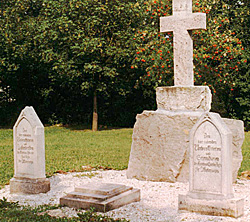 Mass graves of Hanoverian troops at north end of Bad Langensalza.
Mass graves of Hanoverian troops at north end of Bad Langensalza.
The Prussians admit to 41 officers and 805 men killed and wounded, 10 officers and 897 men captured. They claim Hanoverian casualties of 102 officers and 1,327 men killed and wounded.
As soon as the news of the Prussian reverse at Langensalza was received in Berlin, positive orders were sent to General von Falckenstein to concentrate all detachments of the Army of the Main to surround and disarm or destroy the Hanoverian Army without delay. With no sign of movement to their relief by the south German allies, and 40,000 Prussians closing in, the Hanoverians capitulated on 29 June.
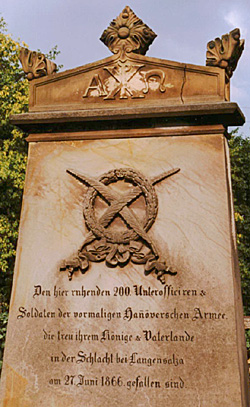 Hanoverian Memorial. Inscription: Here rest 200 noncommissioned officers and soldiers of the former Hanoverian Army fallen for their King and Fatherland in the Battle of Langensalza on 27 June 1866.
Hanoverian Memorial. Inscription: Here rest 200 noncommissioned officers and soldiers of the former Hanoverian Army fallen for their King and Fatherland in the Battle of Langensalza on 27 June 1866.
Bad Langensalza has survived the passage of time with little damage to the battle area. The Kallenbergsmuhle, much modernised, continues to grind grain at the same location. The Salza stream now enters the Unstrut much closer to the bridge, and no trace remains of the bathing establishment in what is now a plowed field. A modern concrete bridge now spans the Unstrut where the 25th (Rhineland) Infantry came to grief. The river, a rather feeble-looking barrier, still flows unimpeded by development. The village of Merxleben, a maze of steep, narrow lanes, appears little changed from the Nineteenth Century. The Kirchberg remains an open grainfield with excellent views, just as inviting for artillery as when the Hanoverian batteries thundered there on 27 June, 1866.
Tourist Information
Access to Bad Langensalza is readily available by swift and comfortable Deutsche Bahn trains for connections from anywhere in Germany. By automobile, the best approach is by Autobahn A4 to Gotha, then north on B-247 which is the same road used by General von Flies' Prussians on their advance to and retreat from Langensalza. The battle sites and monuments are clustered on the northeast edge of the town. The location of each monument is indicated on the detailed Stadtplan map available at local stores.
Visitors to the area would do well to explore the rugged and heavily forested hills of the Thuringer Wald just south of Gotha, an important strategic barrier in innumerable campaigns over the centuries. This is also a favorite resort area for hiking and cross-country skiing. A mere 70 km east of Gotha (half an hour at autobahn speeds) is the Napoleonic battlefield of Jena-Auerstadt.
Bibliography
Prussian General Staff. Campaign of 1866 in Germany. Translated into English by Col. Wright and Cpt. Hozier. 1872. Reprinted by The Battery Press, Nashville, TN, 1994.
Wawro, Geoffrey. The Austro-Prussian War: Austria's War with Prussia and Italy in 1866. Cambridge University Press, 1996.
Frye, Keith. "Battle of Langensalza." Clash of Empires No. 5/6, 1999. Maps by Pat Condray.
Bad Langensalza Stadtplan: Wanderkarte mit Radtouren. 3. Auflage. Grothus Verlag, Kassel.
More Bad Langensalza
Back to List of Battlefields
Back to Travel Master List
Back to MagWeb Master List of Magazines
© Copyright 2000 by Bill Peterson.
This article appears in MagWeb (Magazine Web) on the Internet World Wide Web.
Other military history articles and gaming articles are available at http://www.magweb.com